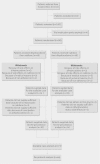Comparison of analgesic effects and patient tolerability of nabilone and dihydrocodeine for chronic neuropathic pain: randomised, crossover, double blind study
- PMID: 18182416
- PMCID: PMC2213874
- DOI: 10.1136/bmj.39429.619653.80
Comparison of analgesic effects and patient tolerability of nabilone and dihydrocodeine for chronic neuropathic pain: randomised, crossover, double blind study
Abstract
Objective: To compare the analgesic efficacy and side effects of the synthetic cannabinoid nabilone with those of the weak opioid dihydrocodeine for chronic neuropathic pain.
Design: Randomised, double blind, crossover trial of 14 weeks' duration comparing dihydrocodeine and nabilone.
Setting: Outpatient units of three hospitals in the United Kingdom.
Participants: 96 patients with chronic neuropathic pain, aged 23-84 years.
Main outcome measures: The primary outcome was difference between nabilone and dihydrocodeine in pain, as measured by the mean visual analogue score computed over the last 2 weeks of each treatment period. Secondary outcomes were changes in mood, quality of life, sleep, and psychometric function. Side effects were measured by a questionnaire.
Intervention: Patients received a maximum daily dose of 240 mg dihydrocodeine or 2 mg nabilone at the end of each escalating treatment period of 6 weeks. Treatment periods were separated by a 2 week washout period. Results Mean baseline visual analogue score was 69.6 mm (range 29.4-95.2) on a 0-100 mm scale. 73 patients were included in the available case analysis and 64 patients in the per protocol analysis. The mean score was 6.0 mm longer for nabilone than for dihydrocodeine (95% confidence interval 1.4 to 10.5) in the available case analysis and 5.6 mm (10.3 to 0.8) in the per protocol analysis. Side effects were more frequent with nabilone.
Conclusion: Dihydrocodeine provided better pain relief than the synthetic cannabinoid nabilone and had slightly fewer side effects, although no major adverse events occurred for either drug.
Trial registration: Current Controlled Trials ISRCTN15330757 controlled-trials.com] .
Conflict of interest statement
Competing interests: BF’s salary was provided as part of the above research grant although he was employed by the Newcastle upon Tyne University Hospitals Trust. None of the other authors have any competing interests.
Comment in
-
Cannabinoids for chronic pain.BMJ. 2008 Jan 26;336(7637):167-8. doi: 10.1136/bmj.39434.444583.80. Epub 2008 Jan 8. BMJ. 2008. PMID: 18182415 Free PMC article.
References
-
- Rog DJ, Nurmikko TJ, Friede T, Young CA. Randomized, controlled trial of cannabis-based medicine in central pain in multiple sclerosis. Neurology 2005;65:812-9. - PubMed
-
- Pertwee RG. Cannabinoid receptor ligands: clinical and neuropharmacological considerations, relevant to future drug discovery and development. Expert Opin Investig Drugs 2000;9:1553-71. - PubMed
-
- Rubin A, Lemberger L, Warrick P, Crabtree RE, Sullivan H, Rowe H, et al. Physiologic disposition of nabilone, a cannabinol derivative, in man. Clin Pharmacol Ther 1977;22:85-91. - PubMed
Publication types
MeSH terms
Substances
Associated data
LinkOut - more resources
Full Text Sources
Other Literature Sources
Medical


